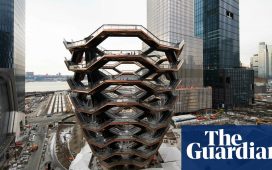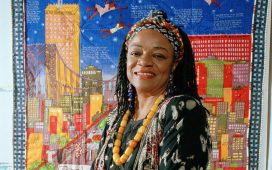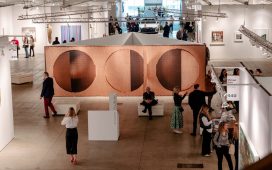Art Basel will hold its 2021 Swiss edition this September
Courtesy of Art Basel
Art Basel has announced the exhibitor list for the upcoming edition of its flagship fair (due to run from 20-26 September, Messe Basel) in which 273 galleries from 33 countries will participate. In a promising sign that the international art fair circuit is returning to pre-pandemic levels of activity, this is just 15 fewer galleries than were planned to show in the cancelled 2020 edition.
Returning to the fair are major global outfits such as David Zwirner, Gagosian and Thaddaeus Ropac. Meanwhile, 24 galleries will be making their Art Basel debuts. They include Ben Brown Fine Arts based in London, Hong Kong and Palm Beach, LambdaLambdaLambda from Pristina, Berlin’s Lars Friedrich and Cardi Gallery, which has spaces in Milan and London.
By far the largest in-person fair to go ahead in Europe since the beginning of the Covid pandemic, Art Basel 2021 will take a number of precautionary measures imposed by the Swiss government to prevent the spread of the virus, most notably capping visitor attendance at 20% less than previous years.
“While the pandemic has been a time of resilience and innovation, it has not always been one of discovery,” says Art Basel’s global director Marc Spiegler. “Patrons have often not been able to discover the work of new artists; likewise, galleries have not had ample opportunities to meet new collectors.”
The Swiss edition will continue a number of initiatives trialled at Art Basel in Hong Kong that took place in May, such as satellite booths, which are staffed by locals appointed by Art Basel and allow for galleries to have a presence at the fair without having to travel.
However, compared with the Hong Kong edition, in which around half of the participating galleries used a satellite booth, only five galleries (all of which are based in East Asia) will take these up in Basel: STPI, Vitamin Creative Space, Tokyo Gallery + BTAP, Antenna Space and ShanghART Gallery. “98% of the galleries are doing the booths they applied for in 2019. That is big news,” Spiegler says. He attributes this to the relatively minimal amount of travel restrictions currently in place in Switzerland, whereas Hong Kong required international travellers to quarantine for three weeks upon arrival.
Since June, Switzerland has lifted most travel restrictions for fully vaccinated people from a number of locations including the Schengen Area, US, Hong Kong and Australia. However, according to an Art Basel official, the number of galleries using satellite booths could increase in the coming weeks as European travel restrictions remain in flux amid rising infection rates.
A further six galleries will share booths, including Kate Macgarry and The Approach, both based in London.
Art Basel also announced that the Turner Prize-nominated British performance artist Monster Chetwynd and Argentinian multidisciplinary artist Cecilia Bengolea will stage site-specific installations in the Messeplatz exhibition space outside the fair’s hall this year.
How does it stack up to 2020?
When selecting this year’s applicants, Spiegler says that Art Basel gave a “strong preference” to the 288 galleries who successfully applied for the cancelled 2020 fair, meaning that there were a “limited number of reapplications” and a high retention rate between the years.
However, there are still several notable changes to the roster. In total 29 galleries that are listed in the fair’s 2020 exhibitor’s list are not showing in 2021, including 303 Gallery (New York), The Modern Institute (Glasgow) and Galerie Hopkins (Paris).
The reasons for this vary from gallery to gallery, although Art Basel 2021’s newfound proximity to the major contemporary art fairs Fiac in Paris and Frieze London may have forced those with smaller teams and resources to reconsider attending two major fairs within weeks of each other.
Some seem to have been victims of their own success: Jhaveri Contemporary in Mumbai was due to make its Art Basel debut with a booth of work by the late Indian textile sculptor Mrinalini Mukherjee. But the gallery—which later showed Mukherjee’s work in an Art Basel online viewing room (OVR)—sold much of its stock by the artist in the following months, meaning they could no longer stage a booth dedicated to her. Their subsequent 2021 proposal with a different artist was not accepted by the selection committee.
Art Basel stalwart Marlborough, which has recently gone through a major ownership shake up, will not be participating either. The gallery could not be reached for comment.
Conversely, several galleries that were not successful in their 2020 applications were accepted this year including Edouard Malingue Gallery from Hong Kong, which will be showing works by Yu Ji, Ellen Pau and Wong Ping in their debut booth.
Digital is not a deterrent
Much like in Hong Kong, the fair will operate a hybrid model, offering both in-person and online experiences via OVRs and virtual walkthroughs, as well as an increased overall digital presence. This now includes a newly launched podcast, Intersections: The Art Basel Podcast, hosted by Spiegler in which he will speak to leading figures working across creative disciplines including art, architecture and fashion. His first guests include the architect David Adjaye and the record producer Swizz Beatz. Co-hosts of the podcast include the curator Larry Ossei-Mensah and The Art Newspaper‘s contributing art market editor Anny Shaw.
But how many of these technological innovations will stay put in years to come, should the world return to pre-pandemic normality? “While I don’t think our future fairs will look that physically different to those of year’s past, what we can offer in terms of reach will be much bigger,” Spiegler says. “One of the perennial problems of fairs is absent patrons: collectors who can’t be there. Expanding our digital platforms has solved a huge issue that we struggled with previously.”
Unsurprisingly, Spiegler rejects the notion that an increased digital presence could undermine the necessity for the art world to fly to Switzerland. “Having content available ahead of time builds momentum and increases, rather than diminishes, people’s desire to come.”
Comparing the fair to a music concert, Spiegler says: “The more live sets a DJ has online, the better attended their shows are. It hypes people up. The fairs are fun, people like seeing each other, they’re not going to stop wanting that.” Indeed for many, Art Basel 2021 will mark the welcome return to a once packed social calendar on the art world circuit, filled with invaluable in-person exchanges. Here’s hoping for a rager.
• A full list of the galleries participating in Art Basel 2021 can be found here.









